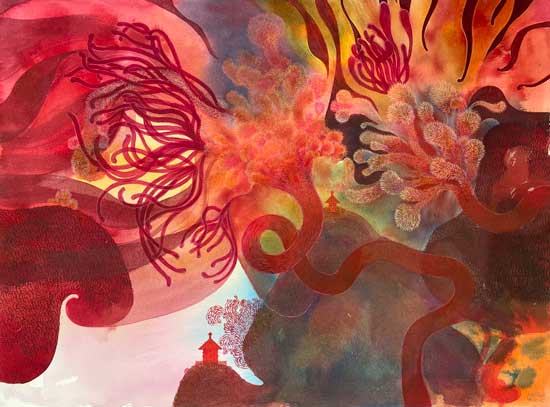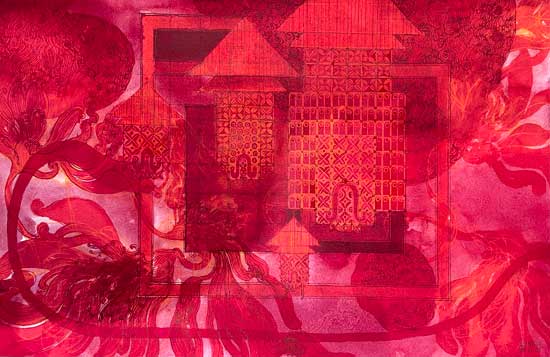Building a bridge between tradition and modernity
Chartered architect, designer and artist, Ajantha Ranaweera is constantly, consciously and often unconsciously, challenging the norms. In his latest exhibition, ‘The Dance of a Water Garden’ –subtitled ‘Symbol of Power, Struggle, Change, and Disappearance’, instead of an artist’s statement that most artists use to explain their work, he chooses to address the viewer directly:

Dear Viewer,
Welcome to The Dance of a Water Garden, an exploration of the intricate relationship between contemporary political power structures and the lived realities of people in post-independence Sri Lanka. This work captures the tension between forces of peace and prosperity, and those of death, destruction, and disappearance…………………..
And it continues, drawing the viewer into a water garden where the water is never still, always in motion, in conflict – a metaphor for the ebb and flow of the nation’s uneasy fortunes since Independence.
That the exhibition comes at a ‘crossroads’ of sorts for the country seems strangely apt. Sri Lanka is emerging from a particularly taxing period and Ajantha freely admits that the years since his first exhibition in 2021 have been challenging. But that has not constrained him from continuing to explore and interpret the dynamics between the centres of power and how it all plays out on the lives of the populace beset by uncertainties and shifting priorities.
He has 18 paintings in this new exhibition at the Paradise Road Galleries and many of them are large – 30” x 22”, a departure from the smaller works at his first exhibition ‘The Boy in Paradise’. His water gardens are highly stylised, non-literal, with an interplay of figures and built structures of varying scales inspired by ancient forms, the interaction of figures embodying those power dynamics in society.
The structures symbolise institutions of power and as Ajantha points out “this juxtaposition underscores the uneasy balance between creation and destruction, growth and disappearance,” the latter the theme of his first exhibition. His question to the viewer: “How do power struggles and the search for balance resonate with your life, your community, and our shared history? And how might they shape our collective future?”

Ajantha’s Water Garden works: Many elements and interactions
Reflecting his design background, his work is all about layering and building – the intricate detailing a strong feature “it takes a long time”, all executed on a limited colour palette, a few base colours, reds, oranges.
Though well versed in the Western principles of design and architecture, Ajantha’s overarching principle is to explore indigenous knowledge to build a bridge between tradition and modernity. He takes inspiration from that rich reservoir of knowledge present in this country, specifically the temple murals, the colours, the faces, traditional elements such as how lianas flow into one another, ‘waka deka’, the basic motif the Sri Lankan artist uses, presenting them in his own aesthetic.

Ajantha Ranaweera
It was at the City School of Architecture that his interest in decolonising knowledge was sparked by lecturers such Dr. Shanti Jayewardene whom he was to later assist with her seminal work on Geoffrey Bawa. His interest in temple murals and the country’s ancient buildings and ruins has long been present, even though frequently frustrated that the custodians of such knowledge in officialdom, the state archaeological authorities, for instance, are resistant to making it available for scholars and people to access and learn from. “How are we to modernise if we don’t have access to our own indigenous knowledge?”
It’s good to have a global contextual approach, but you also have to position our own knowledge within that, give it equal status, rather than the unequal balance (heavily influenced by the West) that prevails at the moment, he feels.
The traditional craftsmen who are stuck in a time warp, are a case in point. They need incentives to move forward, he insists. Why are the old designs not used to create new more functional objects, to meet the current needs. “Use that identity, that flavour but create a new series of functional objects,” he urges. If we are to develop further, we have to find that unique flavor that is our own. …
Central to his own approach is the rasa theory, an aesthetic framework first developed by the Indian sage Bharatha, the “flavour” or “essence” of a profound emotional experience evoked in an audience or viewer. He likens it to a conductor in an orchestra or a director in a play trying to formulate this whole emotional response within a modern concept.
The interconnectedness of it all – art, design, architecture as a natural flow is for him, challenging and stimulating, while more recently AI is a tool he enjoys experimenting with. His vision for his design practice, Dvara Architects and Designers– is as a portal to modern Sri Lankan design. “We don’t just do interiors, rather everything to do with design. We are moving into creative direction, providing the vision and the drive, drawn from a solid knowledge base.”
He hopes his art will also spark conversations, a dialogue into what art could be – reflecting society and leading to a uniquely Sri Lankan yet uni-versally accessible dialogue – it is through that dialogue that this whole concept of modern Sri Lankan design can go forward, he believes.
This exhibition happened through the insistence of Paradise Road founder Shanth Fernando, who kept urging him to work towards another exhibition and so ‘The Dance of a Water Garden’ evolved, with the hope that viewers explore his work – and their own responses to a society still searching for “a more harmonious future”.
Ajantha Ranaweera’s ‘The Dance of a Water Garden’ opened on January 10 and will be on at the Paradise Road Galleries until February 6 from 10 a.m. to midnight.
Searching for an ideal partner? Find your soul mate on Hitad.lk, Sri Lanka's favourite marriage proposals page. With Hitad.lk matrimonial advertisements you have access to thousands of ads from potential suitors who are looking for someone just like you.


